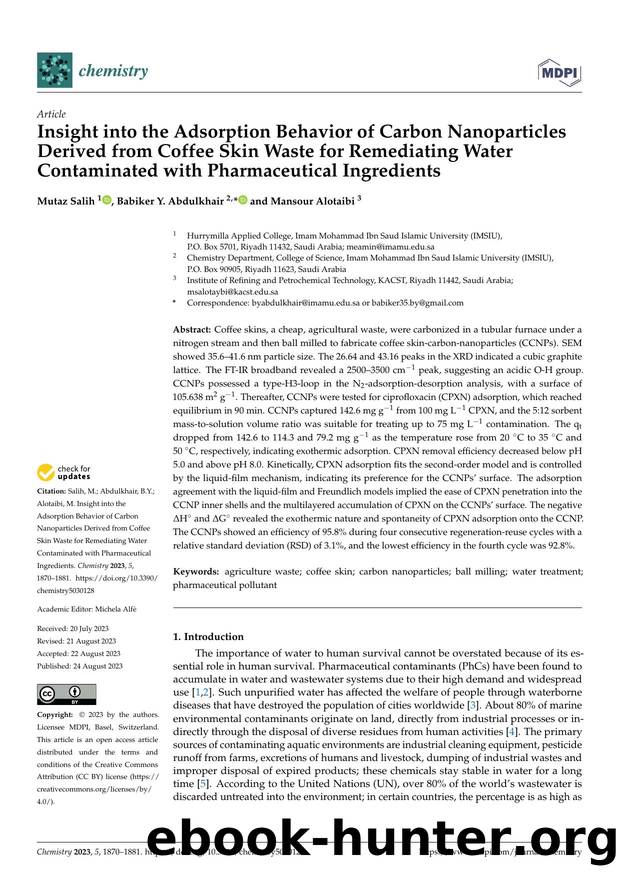Insight into the Adsorption Behavior of Carbon Nanoparticles Derived from Coffee Skin Waste for Remediating Water Contaminated with Pharmaceutical Ingredients by Mutaz Salih Babiker Y. Abdulkhair & Mansour Alotaibi

Author:Mutaz Salih, Babiker Y. Abdulkhair & Mansour Alotaibi
Format: pdf
Tags: Coffee skins, a cheap, agricultural waste, were carbonized in a tubular furnace under a nitrogen stream and then ball milled to fabricate coffee skin-carbon-nanoparticles (CCNPs). SEM showed 35.6–41.6 nm particle size. The 26.64 and 43.16 peaks in the XRD indicated a cubic graphite lattice. The FT-IR broadband revealed a 2500–3500 cm-1 peak, suggesting an acidic O-H group. CCNPs possessed a type-H3-loop in the N2-adsorption-desorption analysis, with a surface of 105.638 m2 g-1. Thereafter, CCNPs were tested for ciprofloxacin (CPXN) adsorption, which reached equilibrium in 90 min. CCNPs captured 142.6 mg g-1 from 100 mg L-1 CPXN, and the 5:12 sorbent mass-to-solution volume ratio was suitable for treating up to 75 mg L-1 contamination. The qt dropped from 142.6 to 114.3 and 79.2 mg g-1 as the temperature rose from 20 C to 35 C and 50 C, respectively, indicating exothermic adsorption. CPXN removal efficiency decreased below pH 5.0 and above pH 8.0. Kinetically, CPXN adsorption fits the second-order model and is controlled by the liquid-film mechanism, indicating its preference for the CCNPs’ surface. The adsorption agreement with the liquid-film and Freundlich models implied the ease of CPXN penetration into the CCNP inner shells and the multilayered accumulation of CPXN on the CCNPs’ surface. The negative H and G revealed the exothermic nature and spontaneity of CPXN adsorption onto the CCNP. The CCNPs showed an efficiency of 95.8% during four consecutive regeneration-reuse cycles with a relative standard deviation (RSD) of 3.1%, and the lowest efficiency in the fourth cycle was 92.8%., agriculture waste; coffee skin; carbon nanoparticles; ball milling; water treatment;pharmaceutical pollutant
Download
This site does not store any files on its server. We only index and link to content provided by other sites. Please contact the content providers to delete copyright contents if any and email us, we'll remove relevant links or contents immediately.
Learning SQL by Alan Beaulieu(6211)
Weapons of Math Destruction by Cathy O'Neil(6146)
Digital Minimalism by Cal Newport;(5664)
iGen by Jean M. Twenge(5366)
Sapiens by Yuval Noah Harari(5294)
The Age of Surveillance Capitalism by Shoshana Zuboff(4209)
Elon Musk by Ashlee Vance(4029)
Thing Explainer by Randall Munroe(3877)
Apollo 8 by Jeffrey Kluger(3637)
Future Crimes by Marc Goodman(3533)
The Science Book (Big Ideas Simply Explained) by DK(3233)
Who Can You Trust? by Rachel Botsman(3088)
Infinite Energy Technologies by Finley Eversole(2939)
I Live in the Future & Here's How It Works by Nick Bilton(2935)
The Innovators: How a Group of Hackers, Geniuses, and Geeks Created the Digital Revolution by Walter Isaacson(2838)
Steve Jobs by Walter Isaacson(2834)
Dawn of the New Everything by Jaron Lanier(2738)
Chernobyl by Serhii Plokhy(2497)
Ben Franklin's Almanac by Candace Fleming(2469)
